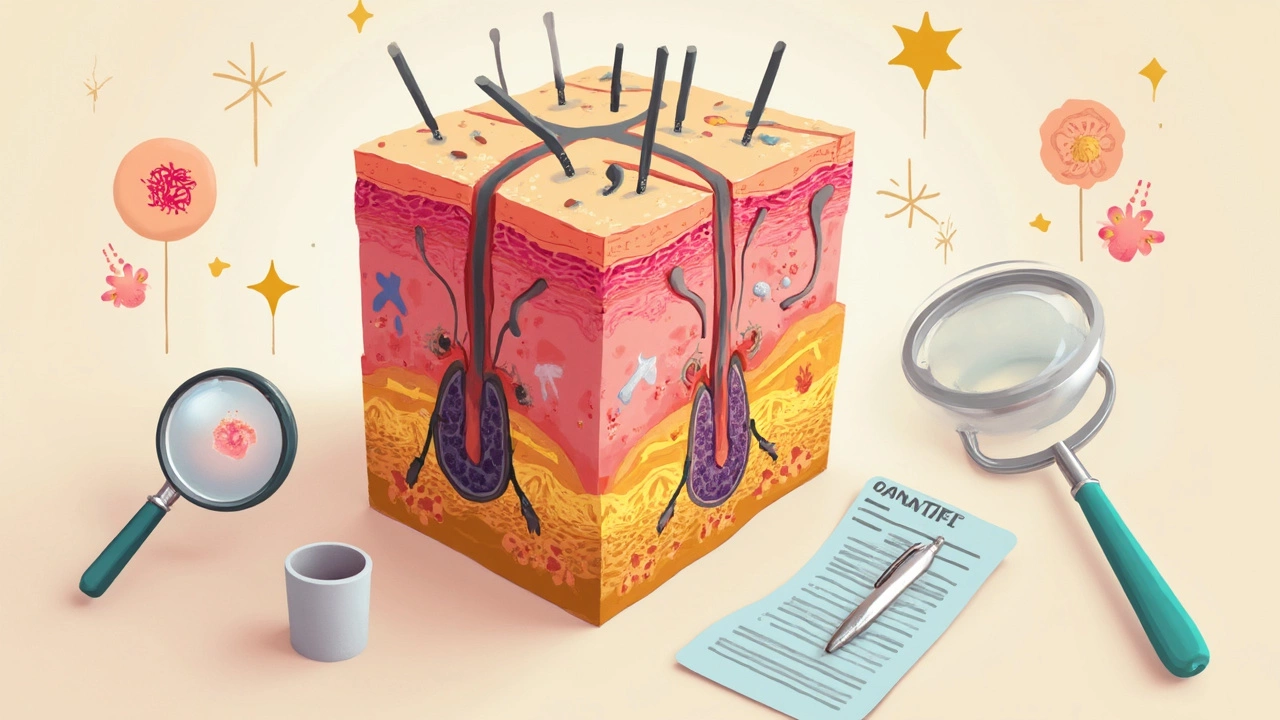If you’re picturing clinical dermatology as just another word for “skin care,” you’d be surprised. It’s not about facials or fancy spa treatments. Clinical dermatology deals with real medical issues—acne that won’t budge, rashes that drive you nuts, weird moles you keep staring at. The focus here is on diagnosing and treating diseases that mess with your skin, hair, and nails.
Doctors trained in clinical dermatology know how to spot the little details that most of us would just Google and shrug off. They use their expertise to figure out whether that persistent dry patch is harmless or a sign of something bigger. For folks with chronic conditions like eczema or psoriasis, clinical dermatology is life-changing—literally.
Ever heard the saying your skin is your body’s biggest organ? That’s why people go to dermatology clinics: to protect something essential. If you’ve ever wondered which doctor to see about a stubborn rash or strange bump, this is the specialty for you. Let’s break down what happens when you walk into a clinical dermatology clinic, what they can fix, and why expert care matters way more than guessing (or that random tube of cream from the drugstore).
- What Is Clinical Dermatology?
- Common Skin Conditions Treated
- How Clinics Diagnose and Treat
- What Makes a Good Dermatology Clinic?
- Tips for Your First Dermatology Visit
What Is Clinical Dermatology?
Clinical dermatology is the branch of medicine that deals with diagnosing, treating, and managing diseases related to the skin, hair, and nails. It’s not about spa treatments or over-the-counter creams—this is about real medical care for real problems. Most people don’t realize that there are over 3,000 known skin conditions, and clinical dermatologists are the go-to experts for handling them.
If you’ve ever worried about a mole, wondered why your acne won’t clear, or struggled with itchy spots that keep spreading, clinical dermatology is where you turn. These doctors go through years of medical school and specialty training just to understand what’s happening beneath the surface. They know how to use everything from old-school techniques (think visual inspection and patient history) to the latest in lab testing and digital imaging.
Unlike cosmetic dermatologists—who focus mostly on appearance—clinical dermatology centers around the health of your skin. This means their main job is sorting out things like rashes, infections, autoimmune diseases, and even skin cancers.
- Diagnosis: Figuring out the cause of a skin issue, often through questions, a physical exam, and sometimes a biopsy or lab test.
- Treatment: Recommending medications, creams, special therapies, or procedures, depending on what you need.
- Management: Helping people with chronic skin problems find long-term solutions, which might include lifestyle changes or regular check-ups.
Just to give you an idea of how common these issues are, more than one in four people visit a dermatologist at some stage in their life, according to some hospital records gathered in the UK and US. Skin cancer rates are on the rise, too, making the job of clinical dermatologists even more important.
So, if you’re searching for help with anything from stubborn warts to warning signs of melanoma, a skin health expert at a dermatology clinic is your best bet. They keep your skin healthy, spot serious worries early, and guide you with proven science—not just guesses or trends.
Common Skin Conditions Treated
Walk into any clinical dermatology clinic, and you’ll see plenty of folks waiting because of stubborn skin problems. These aren’t just minor irritations—they can be painful, embarrassing, or even dangerous if ignored. The list of conditions clinical dermatologists treat is a lot longer than most people think.
Some of the most common reasons people book a visit:
- Acne—This isn’t just a teenage problem. Adults in their forties show up with acne that doesn’t quit. Treatments range from prescription creams and pills to light therapy.
- Eczema (or atopic dermatitis)—This can make your skin red, itchy, and flaky. Clinics have access to targeted creams, oral meds, and even injections for stubborn flare-ups.
- Psoriasis—This causes thick, scaly skin. It can be mild or cover big patches. Dermatologists have the training to spot the difference and recommend the right combos of therapy.
- Rosacea—Think redness and swelling, especially on your face. No, it’s not “just blushing.”
- Skin infections—Anything from fungal issues (like athlete’s foot) to bacterial ones (like impetigo) is treated.
- Mole checks and skin cancer screenings—Probably the most critical reason to see a clinical dermatologist. Finding skin cancer early can literally save your life.
- Hair and nail problems—Yup, they handle weird nail growth, hair loss, and even scalp conditions.
Wondering what brings people into dermatology clinics the most? Check out this simple breakdown:
| Condition | % of Clinic Visits |
|---|---|
| Acne | 25% |
| Eczema | 15% |
| Psoriasis | 10% |
| Skin Infections | 12% |
| Mole/Skin Cancer Checks | 8% |
| Other (Warts, Rosacea, etc.) | 30% |
It's easy to think "it’ll clear up on its own," but persistent problems are worth a professional look. Many treatments now are way more effective than what you’ll find on store shelves. And, you’ll actually know what condition you’re dealing with, instead of guessing and hoping for the best.

How Clinics Diagnose and Treat
When you step into a clinical dermatology clinic, the process kicks off with a solid look at your medical history. Doctors want to know your symptoms, how long you’ve had them, any past issues, and whether anything makes your skin worse or better. This is the stuff that can separate an allergy from something more serious.
Next, comes the skin check. Dermatologists don’t just glance—they really examine your skin, hair, and nails up close, often with a special light or a small handheld scope called a dermatoscope. Suspicious moles and spots? They might take a high-res photo for close tracking over time.
If something looks odd or stubborn, you might need extra tests. Some staples in dermatology clinics include:
- Skin biopsy: Taking a tiny piece of skin to send off to a lab. This helps nail down tough cases, like if a spot might be cancerous.
- Allergy testing: Small patches are stuck to your back (it sounds weird, but it works). After a few days, the doctor checks for reactions.
- Blood tests: Used for autoimmune diseases, infections, and some stubborn rashes.
Treatments are way more specific than a one-size tube of cream. Depending on your diagnosis, your options can include:
- Topical meds: Creams, gels, or ointments—tailored for your issue.
- Oral meds: Pills for infections, acne, or immune problems.
- Light therapy: Special UV light in a clinic, used for things like psoriasis.
- Minor surgeries: Removing moles, cysts, or warts—sometimes right in the office.
- Injections: For conditions like stubborn cystic acne or even hair loss.
Here’s something interesting: According to the American Academy of Dermatology, about 1 in 5 Americans will develop skin cancer in their lifetime. That’s why clinics stress regular check-ups—catching issues early makes treatments way less intense and much more successful.
The bottom line? Clinical dermatology isn’t just about treating what you see. It’s about finding out what’s going on underneath and picking the right tool for the job. You get care made for you, not a quick fix off the shelf.
What Makes a Good Dermatology Clinic?
Picking a clinical dermatology clinic can change everything about your skin health, so it pays to know what actually makes one stand out. Forget about fancy logos or marble floors—focus on what really matters for your care.
First off, you want a clinic with certified dermatologists. Board certification means the doctors have serious training and have passed tough exams. You don’t want anyone treating your skin who just took a weekend course. Look them up; clinics usually show off their team’s credentials online.
Modern clinics invest in updated equipment. Things like dermatoscopes for spotting suspicious moles, digital imaging to track changes, and even laser devices for treatments. Tech matters because it means quicker, more accurate diagnosis and less guesswork.
Good clinics take time talking with you. If the doctor rushes in and barely looks at your skin or doesn’t explain things in plain English, that’s a red flag. Patients consistently say that clear, honest communication builds trust and helps them stick to treatments.
Services are a big one. Does the clinic offer a wide range of treatments for both common issues like acne and eczema, plus tougher stuff like skin cancer checks? More options mean you’re not stuck bouncing between clinics if something unusual pops up later.
Another thing to look for: short wait times. According to a recent survey, people list “quick appointments” as their top wish when visiting a dermatology clinic. Here’s a quick look at what matters most when choosing a clinic:
| Key Feature | Why It Matters |
|---|---|
| Board-Certified Doctors | Means solid training and experience |
| Modern Equipment | Better and faster diagnosis |
| Clear Communication | Helps you understand and follow treatment |
| Diverse Services | Covers everything from rashes to cancer checks |
| Short Wait Times | Makes it easier to get help when you need it |
And if you can, read real reviews—not just the ones on the clinic’s site. Watch for repeated complaints about wait times, surprise costs, or unfriendly staff. Your skin deserves care you can trust, not just a pretty waiting room. Stick with the clinics that nail these basics, and you’ll see the difference fast.

Tips for Your First Dermatology Visit
Walking into a clinical dermatology clinic for the first time can feel weird if you’ve never done it. You might be nervous or not sure what to expect. Here’s what helps things go way smoother and gets you better answers fast.
- Bring a list of your symptoms. Don’t just rely on your memory. Note when your itching, rash, or spots started, how they’ve changed, and if anything makes them better or worse. The more details, the quicker your skin health gets sorted.
- Take photos before your visit. Skin stuff can change day to day. Bring phone photos of what your skin looked like on a “bad day” or when the problem first popped up. This helps your doctor see the full story.
- Know your family history. If relatives have had weird moles, skin cancer, psoriasis, or other skin conditions, it’s worth mentioning. Genetics play a big role in skin treatment decisions.
- Don’t wear makeup or nail polish. Clean skin gives the dermatologist a better view. Skip heavy lotions, foundation, and polish so nothing hides key signs.
- List any products and medicines you use. Bring a photo of your skincare shelf or write down everything you use regularly, including prescription meds. Some reactions or acne can be triggered by stuff you didn’t think mattered.
- Prepare your questions. Ask what your diagnosis actually means, how long treatment will take, possible side effects, and if you need future checkups. If something doesn’t make sense, say so—dermatologists have heard it all.
You’ll probably spend 10-20 minutes in the exam room. Most clinics are used to quick turnarounds. Here’s a stat for you: at many top dermatology clinics, a standard new patient visit averages just 15 minutes (according to a 2023 American Academy of Dermatology survey). Go in with a plan so you get answers that matter to you.
Finally, don’t stress if you feel embarrassed about your skin. Dermatologists see everything—from severe acne to fungal toenails—every single day. Their job is to help, not judge.

